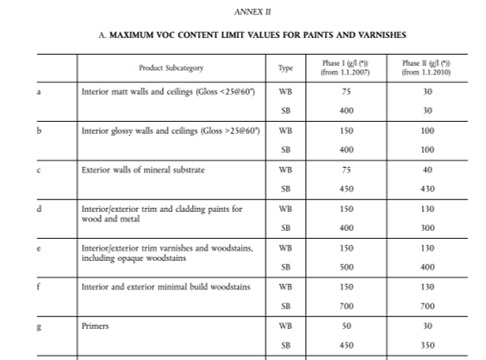Volatile Organic Compounds (VOC) and Consumer Products Regulations
Little Pro on 2018-02-13
Volatile organic compounds(VOCs) are organic chemical compounds which can quickly evaporate to air due to their high vapour pressure and low boiling point. Common VOCs include ethanol, formaldehyde, benzene, toluene and xylene. VOCs are of concern to both indoor air quality and outdoor quality. Indoor VOCs are usually emitted from consumer products and building materials such as paints and carpets and may adversely impact the health of people that are exposed. Outdoor VOCs are usually emitted from industrial facilities and vehicles and may contribute to the formation of photochemical smog. Many countries have implemented regulations to limit the use of VOCs in consumer products. In this article, we will summarize different definitions of VOC and give you an overview of VOC content limits for consumer products in USA, Canada and EU.
Definitions of VOCs - Similar But Different
Each jurisdiction or country may have different official definitions for VOCs depending on whether the VOCs are indoor VOCs or outdoor VOCs. There is usually no detailed list of VOCs. However, some volatile organic substances may be excluded from the definition of VOCs due to their low concern.
| Jurisdiction | Definition |
|---|---|
| USA |
|
| Canada |
|
| EU |
|
| China |
|
| Japan |
|
VOC Regulations for Consumer Products in USA
US EPA has established National Volatile Organic Compound Emission Standards for Consumer Products mandating the VOC limits for a wide range of consumer products (see picture below). In addition, many states (i.e. California) have draft their own VOC content limits for consumer products and these limits sometimes can be tougher than EPA's limits.

To access detailed VOC content limits, please click the links below.
- National Volatile Organic Compound Emission Standards for Consumer Products - US EPA
- State and Federal VOC Limitations for Institutional and Consumer Products - ISSA
VOC Regulations for Consumer Products in Canada
Environment Canada published revised proposed Volatile Organic Compound (VOC) Concentration Limits for Certain Products Regulations in 2013. If coming into force, the revised regulation would set VOC content limits for 98 categories of certain products, including personal care products, household maintenance products, adhesives, coatings and automotive refinishing products. The proposed VOC limits are intended to alighn as closely as possible with those set by California Air Resources Board (CARB) and US EPA.
To access the proposed VOC limits, please click the link below:
VOC Regulations for Consumer Products in EU
In EU, Directive 2004/42/EC on the limitation of emissions of volatile organic compounds due to the use of organic solvents in decorative paints and varnishes and vehicle refinishing products sets the maximum contents of VOCs (in g/L) in paints, varnishes and vehice refinishing products. The directive also requires that suppliers label the subcategory of the product, the legal limit value for VOC contents and the maximum content of VOC of the product in its ready to use condition.
The picture below shows the VOC content limits for some paints:

To access the complete list of VOC limits for paints in EU, please click the link below:
Having Questions?
We do not provide consultancy services. If you have questions or need any help, please contact our sponsor. You may also find an expert in CSP business directory below. If you are a consultant, you may get yourself listed in CSP business directory (free) or sponsor this page to leave your contact info on this page..

Tags: Topics - Restriction, Substance Restriction in Articles